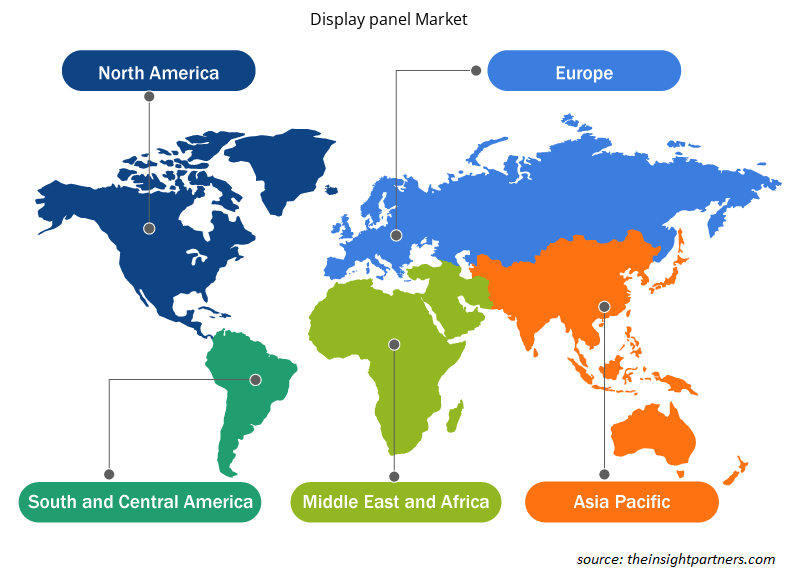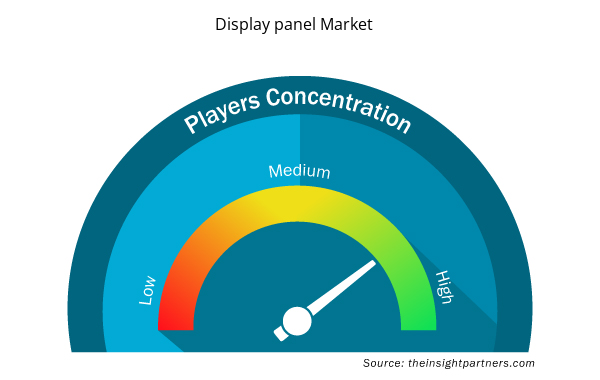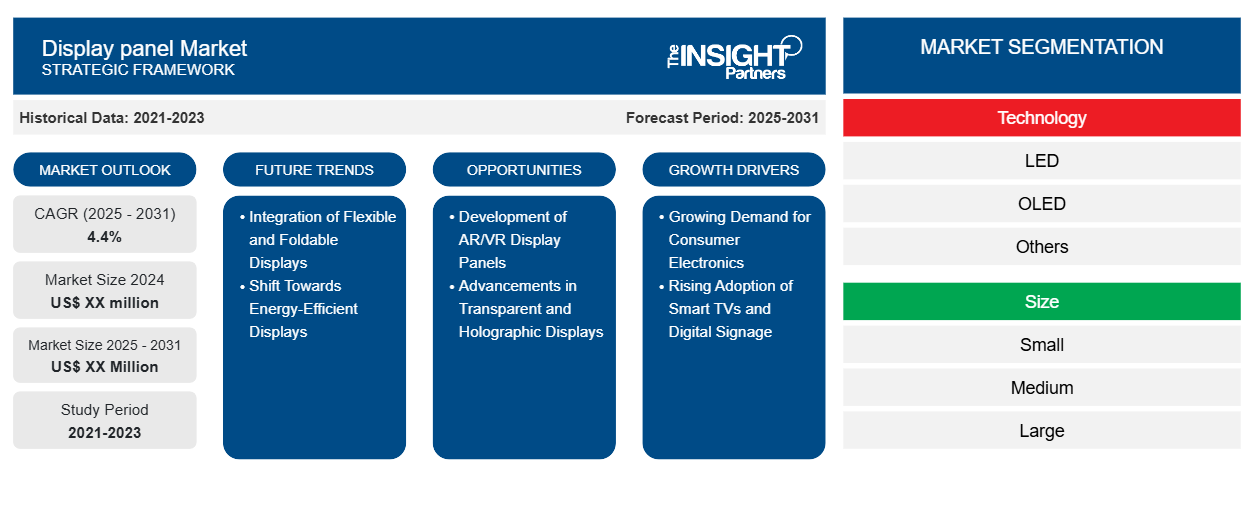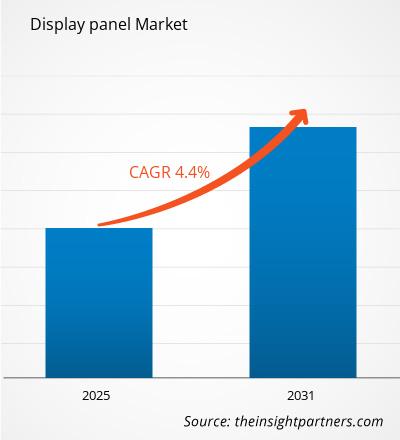Se espera que el mercado de paneles de visualización registre una CAGR del 4,4 % entre 2023 y 2031, con un tamaño de mercado que se expandirá de US$ XX millones en 2023 a US$ XX millones en 2031.
El informe está segmentado por tecnología (LED, OLED, otros); tamaño (pequeño, mediano, grande); factor de forma (plano, flexible); resolución (8K, 4K, WQHD, FHD, HD, otros); aplicación (televisión, monitor de escritorio, computadora portátil, tableta, teléfono móvil, automotriz, señalización digital, otros). El análisis global se desglosa aún más a nivel regional y por países principales. El informe ofrece el valor en USD para el análisis y los segmentos anteriores.
Propósito del Informe
El informe Panel de visualización del mercado de The Insight Partners tiene como objetivo describir el panorama actual y el crecimiento futuro, los principales factores impulsores, los desafíos y las oportunidades. Esto proporcionará información a diversas partes interesadas del negocio, como:
- Proveedores/fabricantes de tecnología: Para comprender la dinámica cambiante del mercado y conocer las oportunidades potenciales de crecimiento, lo que les permitirá tomar decisiones estratégicas informadas.
- Inversionistas: Realizar un análisis exhaustivo de tendencias sobre la tasa de crecimiento del mercado, las proyecciones financieras del mercado y las oportunidades que existen en toda la cadena de valor.
- Órganos reguladores: Regular las políticas y vigilar las actividades del mercado con el objetivo de minimizar los abusos, preservar la confianza de los inversores y defender la integridad y la estabilidad del mercado.
Segmentación del mercado de paneles de visualización
Tecnología
- CONDUJO
- Pantalla OLED
- Otros
Tamaño
- Pequeño
- Medio
- Grande
Factor Granja
- Departamento
- Flexible
Resolución
- 8K
- 4K
- Alta definición de gran calidad
- Full HD (alta definición)
- Alta definición
- Otros
Resolución
- 8K
- 4K
- Alta definición de gran calidad
- Full HD (alta definición)
- Alta definición
- Otros
Personalice este informe según sus necesidades
Obtendrá personalización en cualquier informe, sin cargo, incluidas partes de este informe o análisis a nivel de país, paquete de datos de Excel, así como también grandes ofertas y descuentos para empresas emergentes y universidades.
- Obtenga las principales tendencias clave del mercado de este informe.Esta muestra GRATUITA incluirá análisis de datos, desde tendencias del mercado hasta estimaciones y pronósticos.
Factores impulsores del crecimiento del mercado del panel de visualización
- Demanda creciente de productos electrónicos de consumo: la creciente demanda de productos electrónicos de consumo, como teléfonos inteligentes, televisores, computadoras portátiles y tabletas, es un factor importante que impulsa el mercado de los paneles de visualización. Con los continuos avances en la tecnología y el aumento de los ingresos disponibles, los consumidores buscan dispositivos con una calidad visual mejorada, lo que contribuye a la adopción de pantallas de alta resolución como los paneles OLED, LCD y AMOLED. Esta demanda impulsa a los fabricantes a desarrollar paneles de visualización más innovadores, con más funciones y eficientes.
- Creciente adopción de televisores inteligentes y señalización digital: la creciente demanda de televisores inteligentes con mejor calidad de imagen y funciones avanzadas es un importante impulsor del mercado de paneles de visualización. A medida que los consumidores pasan a pantallas más grandes con mejor resolución y capacidades inteligentes, aumenta la necesidad de paneles de visualización de alta calidad como OLED y QLED. Además, el uso cada vez mayor de la señalización digital en publicidad, comercio minorista y espacios públicos está impulsando la adopción de paneles grandes de alta definición, lo que expande aún más el mercado.
Panel de visualización Tendencias futuras del mercado
- Integración de pantallas flexibles y plegables: una tendencia notable en el mercado de paneles de visualización es el auge de las pantallas flexibles y plegables, en particular en teléfonos inteligentes, dispositivos portátiles y otros dispositivos portátiles. Los paneles OLED flexibles permiten dispositivos que se pueden doblar o plegar, lo que ofrece nuevos formatos y experiencias de usuario. Esta tendencia está ampliando los límites del diseño de dispositivos, ofreciendo productos más compactos, portátiles y versátiles que satisfacen las necesidades y preferencias cambiantes de los consumidores.
- Cambio hacia pantallas energéticamente eficientes: a medida que aumentan las preocupaciones medioambientales y los costes energéticos, existe una tendencia creciente hacia tecnologías de pantallas energéticamente eficientes. Los consumidores y las empresas buscan cada vez más pantallas que consuman menos energía y ofrezcan imágenes de alta calidad. Tecnologías como OLED, que consumen menos energía que los paneles LCD tradicionales, están ganando popularidad. Además, la demanda de pantallas con un menor impacto medioambiental, como materiales reciclables y ecológicos, también se está convirtiendo en una tendencia importante en la industria.
Panel de visualización Oportunidades de mercado
- Desarrollo de paneles de visualización de realidad aumentada y realidad virtual: con el rápido desarrollo de las tecnologías de realidad aumentada (RA) y realidad virtual (RV), existe una creciente demanda de paneles de visualización especializados diseñados para experiencias inmersivas. La necesidad de pantallas de alta definición, baja latencia y amplio campo de visión está creando nuevas oportunidades para que los fabricantes de paneles de visualización desarrollen productos para aplicaciones de RA y RV en los sectores de los juegos, la educación, la atención médica y otras industrias, ampliando así su alcance de mercado.
- Avances en pantallas transparentes y holográficas: Otra oportunidad interesante en el mercado de paneles de visualización es el desarrollo de pantallas transparentes y holográficas. Estas pantallas, que permiten a los usuarios interactuar con contenido digital en tiempo real a través de proyecciones transparentes o en 3D, están encontrando aplicaciones en sectores como el comercio minorista, la publicidad, la automoción y la atención sanitaria. A medida que la tecnología madura y se vuelve más asequible, las pantallas transparentes y holográficas ofrecen una vía prometedora para la innovación y la expansión del mercado.
Panel de visualización Perspectivas del mercado regional
Los analistas de Insight Partners explicaron en detalle las tendencias y los factores regionales que influyen en el mercado de paneles de visualización durante el período de pronóstico. Esta sección también analiza los segmentos y la geografía del mercado de paneles de visualización en América del Norte, Europa, Asia Pacífico, Oriente Medio y África, y América del Sur y Central.

- Obtenga los datos regionales específicos para el mercado de paneles de visualización
Panel de visualización Alcance del informe de mercado
| Atributo del informe | Detalles |
|---|---|
| Tamaño del mercado en 2023 | XX millones de dólares estadounidenses |
| Tamaño del mercado en 2031 | US$ XX millones |
| CAGR global (2023 - 2031) | 4,4% |
| Datos históricos | 2021-2022 |
| Período de pronóstico | 2024-2031 |
| Segmentos cubiertos | Por tecnología
|
| Regiones y países cubiertos | América del norte
|
| Líderes del mercado y perfiles de empresas clave |
|
Panel de visualización Densidad de actores del mercado: comprensión de su impacto en la dinámica empresarial
El mercado de paneles de visualización está creciendo rápidamente, impulsado por la creciente demanda de los usuarios finales debido a factores como la evolución de las preferencias de los consumidores, los avances tecnológicos y una mayor conciencia de los beneficios del producto. A medida que aumenta la demanda, las empresas amplían sus ofertas, innovan para satisfacer las necesidades de los consumidores y aprovechan las tendencias emergentes, lo que impulsa aún más el crecimiento del mercado.
La densidad de actores del mercado se refiere a la distribución de las empresas o firmas que operan dentro de un mercado o industria en particular. Indica cuántos competidores (actores del mercado) están presentes en un espacio de mercado determinado en relación con su tamaño o valor total de mercado.
Las principales empresas que operan en el mercado de paneles de visualización son:
- Corporación AU Optronics
- Grupo Tecnológico BOE Co. Ltd.
- Tubos de imágenes Chunghwa Ltd.
- Corporación de visualización HannStar
- Corporación Innolux
Descargo de responsabilidad : Las empresas enumeradas anteriormente no están clasificadas en ningún orden particular.

- Obtenga el panel de visualización Descripción general de los principales actores clave del mercado
Puntos de venta clave
- Cobertura integral: el informe cubre de manera integral el análisis de productos, servicios, tipos y usuarios finales del mercado de paneles de visualización, proporcionando un panorama holístico.
- Análisis de expertos: el informe se compila sobre la base de un profundo conocimiento de expertos y analistas de la industria.
- Información actualizada: El informe asegura relevancia comercial debido a su cobertura de información reciente y tendencias de datos.
- Opciones de personalización: este informe se puede personalizar para satisfacer los requisitos específicos del cliente y adaptarse adecuadamente a las estrategias comerciales.
Por lo tanto, el informe de investigación sobre el mercado de paneles de visualización puede ayudar a abrir camino para descifrar y comprender el escenario de la industria y las perspectivas de crecimiento. Si bien puede haber algunas preocupaciones válidas, los beneficios generales de este informe tienden a superar las desventajas.
- Análisis histórico (2 años), año base, pronóstico (7 años) con CAGR
- Análisis PEST y FODA
- Tamaño del mercado Valor/volumen: global, regional, nacional
- Industria y panorama competitivo
- Conjunto de datos de Excel


- Oxy-fuel Combustion Technology Market
- Transdermal Drug Delivery System Market
- Fertilizer Additives Market
- Dealer Management System Market
- Fill Finish Manufacturing Market
- Pressure Vessel Composite Materials Market
- Queue Management System Market
- Point of Care Diagnostics Market
- HVAC Sensors Market
- Sleep Apnea Diagnostics Market

Report Coverage
Revenue forecast, Company Analysis, Industry landscape, Growth factors, and Trends

Segment Covered
This text is related
to segments covered.

Regional Scope
North America, Europe, Asia Pacific, Middle East & Africa, South & Central America

Country Scope
This text is related
to country scope.
Preguntas frecuentes
Some of the customization options available based on the request are an additional 3-5 company profiles and country-specific analysis of 3-5 countries of your choice. Customizations are to be requested/discussed before making final order confirmation# as our team would review the same and check the feasibility
The report can be delivered in PDF/PPT format; we can also share excel dataset based on the request
Technological Advancements in Display Technology is anticipated to play a significant role in the global Display panel market in the coming years
The major factors driving the Display panel market are Growing Demand for High-Quality Displays and Increasing Use of Displays in Automotive Applications.
The Display panel Market is estimated to witness a CAGR of 4.4% from 2023 to 2031
Trends and growth analysis reports related to Electronics and Semiconductor : READ MORE..
1.AU Optronics Corporation
2.BOE Technology Group Co. Ltd.
3.Chunghwa Picture Tubes Ltd.
4.HannStar Display Corporation
5.Innolux Corporation
6.Japan Display Inc.
7.LG Display Co. Ltd.
8.Panasonic Corporation
9.Samsung Electronics Co. Ltd.
10.Sharp Corporation
The Insight Partners performs research in 4 major stages: Data Collection & Secondary Research, Primary Research, Data Analysis and Data Triangulation & Final Review.
- Data Collection and Secondary Research:
As a market research and consulting firm operating from a decade, we have published and advised several client across the globe. First step for any study will start with an assessment of currently available data and insights from existing reports. Further, historical and current market information is collected from Investor Presentations, Annual Reports, SEC Filings, etc., and other information related to company’s performance and market positioning are gathered from Paid Databases (Factiva, Hoovers, and Reuters) and various other publications available in public domain.
Several associations trade associates, technical forums, institutes, societies and organization are accessed to gain technical as well as market related insights through their publications such as research papers, blogs and press releases related to the studies are referred to get cues about the market. Further, white papers, journals, magazines, and other news articles published in last 3 years are scrutinized and analyzed to understand the current market trends.
- Primary Research:
The primarily interview analysis comprise of data obtained from industry participants interview and answers to survey questions gathered by in-house primary team.
For primary research, interviews are conducted with industry experts/CEOs/Marketing Managers/VPs/Subject Matter Experts from both demand and supply side to get a 360-degree view of the market. The primary team conducts several interviews based on the complexity of the markets to understand the various market trends and dynamics which makes research more credible and precise.
A typical research interview fulfils the following functions:
- Provides first-hand information on the market size, market trends, growth trends, competitive landscape, and outlook
- Validates and strengthens in-house secondary research findings
- Develops the analysis team’s expertise and market understanding
Primary research involves email interactions and telephone interviews for each market, category, segment, and sub-segment across geographies. The participants who typically take part in such a process include, but are not limited to:
- Industry participants: VPs, business development managers, market intelligence managers and national sales managers
- Outside experts: Valuation experts, research analysts and key opinion leaders specializing in the electronics and semiconductor industry.
Below is the breakup of our primary respondents by company, designation, and region:

Once we receive the confirmation from primary research sources or primary respondents, we finalize the base year market estimation and forecast the data as per the macroeconomic and microeconomic factors assessed during data collection.
- Data Analysis:
Once data is validated through both secondary as well as primary respondents, we finalize the market estimations by hypothesis formulation and factor analysis at regional and country level.
- Macro-Economic Factor Analysis:
We analyse macroeconomic indicators such the gross domestic product (GDP), increase in the demand for goods and services across industries, technological advancement, regional economic growth, governmental policies, the influence of COVID-19, PEST analysis, and other aspects. This analysis aids in setting benchmarks for various nations/regions and approximating market splits. Additionally, the general trend of the aforementioned components aid in determining the market's development possibilities.
- Country Level Data:
Various factors that are especially aligned to the country are taken into account to determine the market size for a certain area and country, including the presence of vendors, such as headquarters and offices, the country's GDP, demand patterns, and industry growth. To comprehend the market dynamics for the nation, a number of growth variables, inhibitors, application areas, and current market trends are researched. The aforementioned elements aid in determining the country's overall market's growth potential.
- Company Profile:
The “Table of Contents” is formulated by listing and analyzing more than 25 - 30 companies operating in the market ecosystem across geographies. However, we profile only 10 companies as a standard practice in our syndicate reports. These 10 companies comprise leading, emerging, and regional players. Nonetheless, our analysis is not restricted to the 10 listed companies, we also analyze other companies present in the market to develop a holistic view and understand the prevailing trends. The “Company Profiles” section in the report covers key facts, business description, products & services, financial information, SWOT analysis, and key developments. The financial information presented is extracted from the annual reports and official documents of the publicly listed companies. Upon collecting the information for the sections of respective companies, we verify them via various primary sources and then compile the data in respective company profiles. The company level information helps us in deriving the base number as well as in forecasting the market size.
- Developing Base Number:
Aggregation of sales statistics (2020-2022) and macro-economic factor, and other secondary and primary research insights are utilized to arrive at base number and related market shares for 2022. The data gaps are identified in this step and relevant market data is analyzed, collected from paid primary interviews or databases. On finalizing the base year market size, forecasts are developed on the basis of macro-economic, industry and market growth factors and company level analysis.
- Data Triangulation and Final Review:
The market findings and base year market size calculations are validated from supply as well as demand side. Demand side validations are based on macro-economic factor analysis and benchmarks for respective regions and countries. In case of supply side validations, revenues of major companies are estimated (in case not available) based on industry benchmark, approximate number of employees, product portfolio, and primary interviews revenues are gathered. Further revenue from target product/service segment is assessed to avoid overshooting of market statistics. In case of heavy deviations between supply and demand side values, all thes steps are repeated to achieve synchronization.
We follow an iterative model, wherein we share our research findings with Subject Matter Experts (SME’s) and Key Opinion Leaders (KOLs) until consensus view of the market is not formulated – this model negates any drastic deviation in the opinions of experts. Only validated and universally acceptable research findings are quoted in our reports.
We have important check points that we use to validate our research findings – which we call – data triangulation, where we validate the information, we generate from secondary sources with primary interviews and then we re-validate with our internal data bases and Subject matter experts. This comprehensive model enables us to deliver high quality, reliable data in shortest possible time.


 Obtenga una muestra gratuita de este informe
Obtenga una muestra gratuita de este informe